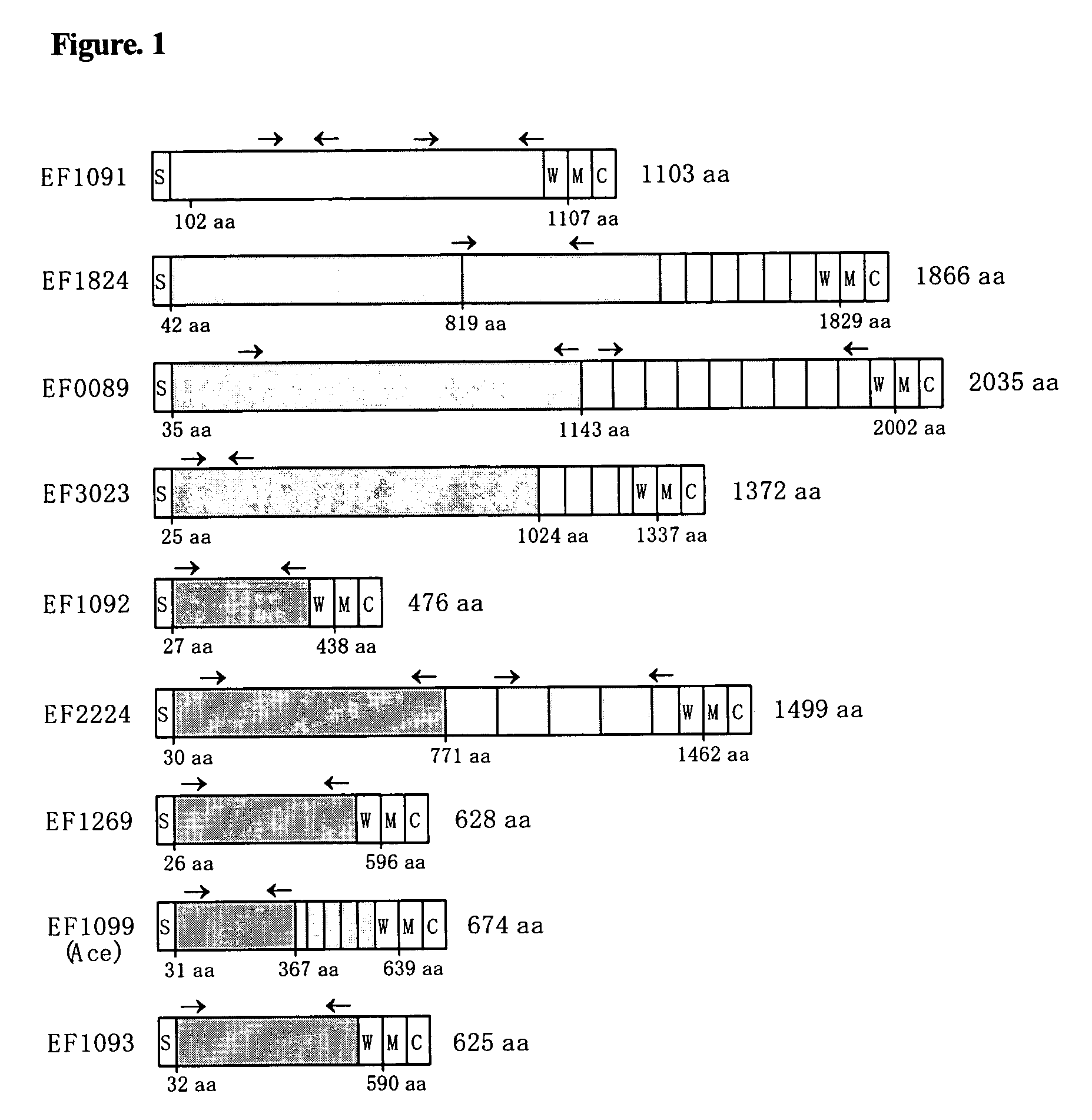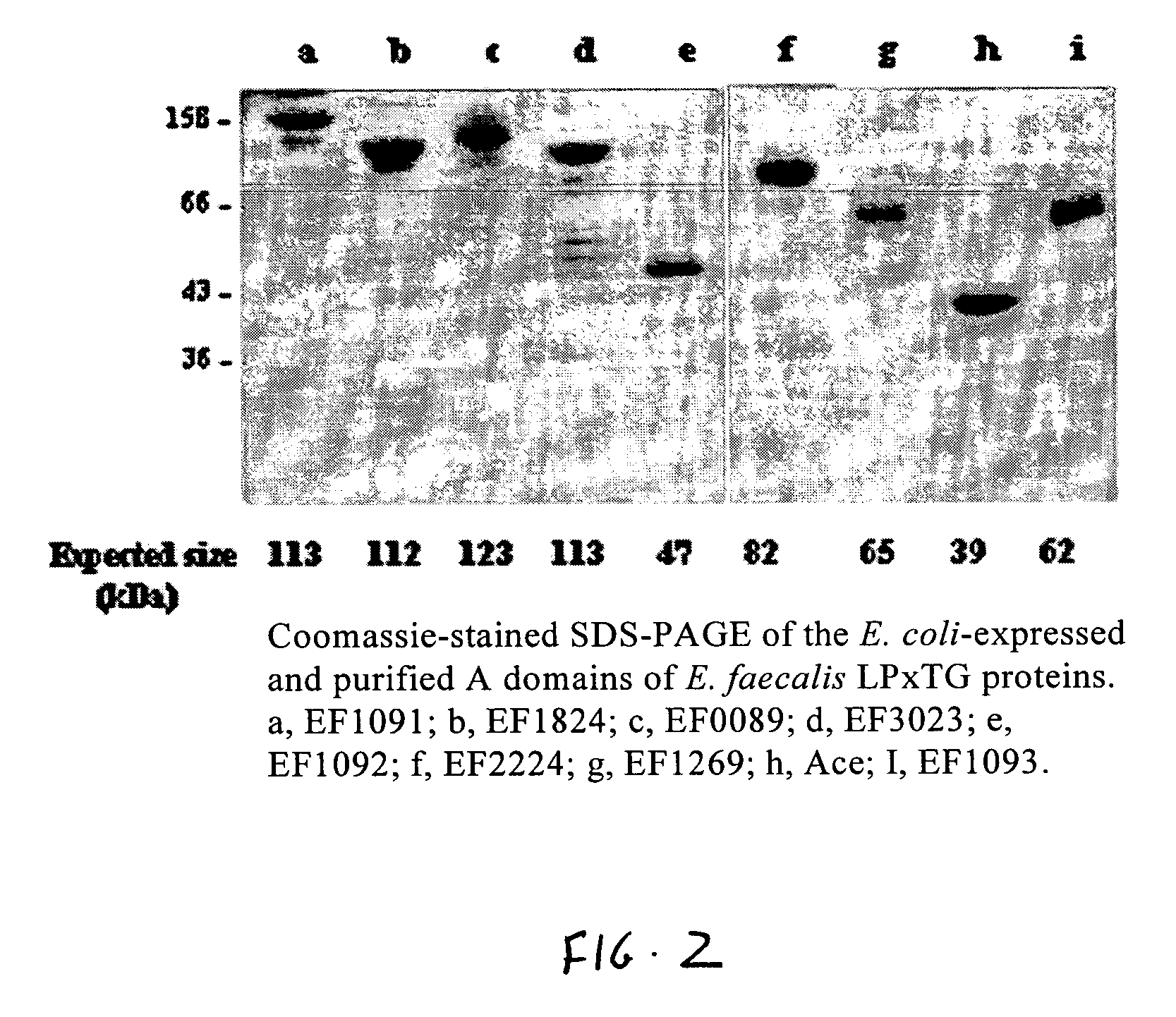Bioinformatic method for identifying surface-anchored proteins from gram-positive bacteria and proteins obtained thereby
- Summary
- Abstract
- Description
- Claims
- Application Information
AI Technical Summary
Benefits of technology
Problems solved by technology
Method used
Image
Examples
example 1
Method to Identify MSCRAMM® Proteins from Gram Positive Bacteria and Expression and Purification of Their A Domains
A. Searching for LPXTG-motif containing cell wall anchored proteins in annotated genomes of Gram-positive bacteria.
[0087]1. Obtain the amino acid sequences of the entire genome of interest from web sites of sequencing centers. These sequences are stored in a local Silicon Graphics machine (SGI).[0088]2. A local searchable database is established using the program format db obtained from NCBI and installed locally on the SGI.[0089]3. LPXTG-motif containing proteins are identified using PHI-blast, which is obtained from NCBI and installed locally on the SGI. The PHI-blast search uses a degenerate LPXTG pattern L-P-X-[TSA]-[GANS], X being any amino acid. The templates for PHI-blast vary depend on the particular organism. For each organism, two known cell wall anchored proteins of S. aureus with no sequence homology were used as well as known cell wall anchored proteins fro...
example 3
MSCRAMM® Genes Common to E. faecalis and E. faecium PCR Analysis
[0108]Primers for flanking regions of sequences above were used to amplify 1μg genomic DNA from each E. faecalis strain. PCR products from 5 E. faecalis strains in Table 1 were sequenced and compared to the TIGR database sequence. Primers used to amplify the enterococcal MSCRAMM® A-domain gene products are shown below.
[0109]
Protein5′=Primer3′=PrimerACE40GAATTGAGCAAAAGTTCAATCGTCTGTCTTTTCACTTGTTTCG (SEQ ID NO: 44)TGTTG(SEQ ID NO: 51)EF1091CAAGTAAAAAAGCCGGTACAGAAAGGAACCTTTGCTTGGTTCC(SEQ ID NO: 45)(SEQ ID NO: 52)EF1092TCGCAAGCAAGCGTTCAAGAAGCCTGACTCTTTTACTTTT(SEQ ID NO: 46)TTATTG(sEQ ID NO: 53)EF1093GAGAGCGCACAGCTCGTGGGTACCTTTGTGTTTGTTTGG(SEQ ID NO: 47)TAC(SEQ ID NO: 54)Efae2924CGGGATCCCAAAACAGCGGGACCCAAGCTTTCATGTACCTTTAAGAAATGAGCGAGTGTTTATTTGG(SEQ ID NO: 48)(SEQ ID NO: 55)Efae2925CGGGATCCGAAATGGTTCAGATCTGCAGTTCAATTGACTACTTTACTTTACACTTCAATATACTGTC(SEQ ID NO: 49)(SEQ ID NO: 56)Efae2926CGGGATCCAAAGCACTGAACACCCAAGCTTTCAGAATGCTT...
example 4
Additional Gram Positive Amino Acid Sequences Predicted to Be MSCRAMM® Proteins
[0113]List of LPXTG-motif containing cell wall anchored proteins that contain predicted immunoglobulin—like fold. The sequencing center for each genome is indicated in the parenthesis. All the sequence except for those of CNA from S. aureus and Staphylococcus epidermidis can be obtained from TIGR website (www.tir.org), comprehensive microbial resource section. The S. epidermidis RP64A genome is not annotated. However, the nucleotide coordinates of the genes encoding the listed S. epidermidis proteins can be obtained through TIGR website.
Streptococcus pneumoniae TIGR4 (TIGR)
[0114]SP0368[0115]SP0462[0116]SP0463[0117]SP0464
Enterococcus faecalis V583 (TIGR)[0118]EF2224[0119]EF1099[0120]EF1092[0121]EF3023[0122]EF1269[0123]EF0089[0124]EF1824[0125]EF1091[0126]EF1093[0127]EF1075[0128]EF1074[0129]EF1651
Streptococcus mutans UA159 (University of Oklahoma)[0130]SMU.610[0131]SMU.987[0132]SMU.63c
Staphylococcus aureus N...
PUM
| Property | Measurement | Unit |
|---|---|---|
| pH | aaaaa | aaaaa |
| volume | aaaaa | aaaaa |
| pH | aaaaa | aaaaa |
Abstract
Description
Claims
Application Information
 Login to View More
Login to View More - R&D
- Intellectual Property
- Life Sciences
- Materials
- Tech Scout
- Unparalleled Data Quality
- Higher Quality Content
- 60% Fewer Hallucinations
Browse by: Latest US Patents, China's latest patents, Technical Efficacy Thesaurus, Application Domain, Technology Topic, Popular Technical Reports.
© 2025 PatSnap. All rights reserved.Legal|Privacy policy|Modern Slavery Act Transparency Statement|Sitemap|About US| Contact US: help@patsnap.com


